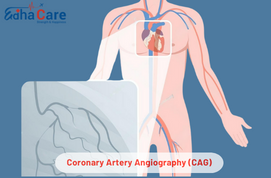Coronary Artery Angiography (CAG)

Coronary Artery Angiography (CAG) is a diagnostic procedure used to evaluate the health of the arteries known as the coronary arteries, which supply blood to the heart muscle. To see any blockages or narrowing in the arteries, X-ray images are obtained when a specific dye is injected during CAG. This technique aids in the diagnosis of diseases including coronary artery disease (CAD) and the measurement of arterial blockages. Usually carried out in a hospital context, CAG is frequently done in conjunction with cardiac catheterization procedures. It offers important information that helps with treatment choices, like if an angioplasty or bypass procedure is required to get the heart's blood flow back to normal.
Book an AppointmentAbout Coronary Artery Angiography (CAG)
Symptoms: If a patient has angina (chest pain), shortness of breath, exhaustion, or other heart-related symptoms, they may need to get a coronary artery disease (CAD) CT scan.
Causes: Coronary artery geometry (CAG) is used to see irregularities in the coronary arteries, such as narrowing or blockages, that may point to coronary artery disease (CAD). For those who have risk factors such as elevated cholesterol levels, diabetes, high blood pressure, smoking, being overweight, or a family history of heart disease, it is frequently advised.
Solutions: CAG is a diagnostic tool to help direct future management and therapy decisions depending on the findings; it is not a treatment in and of itself. Depending on the severity and breadth of coronary artery disease found, treatment options may include lifestyle modifications, medication, angioplasty, stent implantation, or coronary artery bypass graft (CABG).
Procedure of Coronary Artery Angiography (CAG)
Preparation: The patient is made ready by getting their informed consent, going over their medical history, and having any medication or contrast dye allergies evaluated.
Anesthesia: To make the area numb, local anesthetic is injected at the insertion site, which is typically the wrist or groin.
Insertion of the Catheter: Under fluoroscopy supervision, a small incision is made in the groin or wrist, and a thin, flexible catheter is placed into the artery.
Guiding Catheter Placement: The coronary arteries are reached by the catheter after it has been guided via the blood channels.
Contrast Injection: By injecting contrast dye through the catheter, any blockages or anomalies in the coronary arteries can be seen during X-ray imaging, or angiography.
Image Acquisition: When the contrast dye passes through the coronary arteries, X-ray images are taken, giving precise information about blood flow and any obstructions in the arteries.
Removal of the Catheter: To stop bleeding, pressure is applied to the site of insertion after the procedure and the catheter is removed. In addition to receiving post-procedure care instructions, the patient is watched closely for any issues.
Require Assistance?
Get A Quick Callback From Our Healthcare Experts
Other Specilities We Cover

Robotic Heart Bypass Surgery

Heart Bypass Surgery




